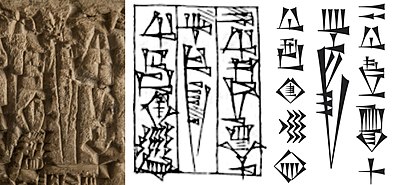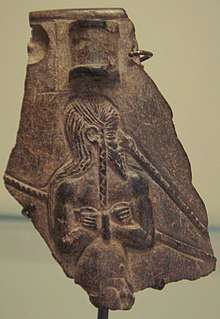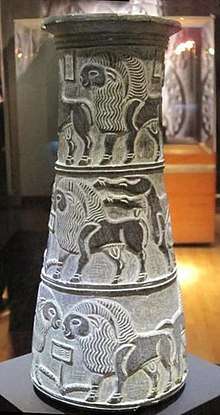Marhasi
Marhaši (Sumerian: Mar-ḫa-šiKI 𒈥𒄩𒅆𒆠, Marhashi, Marhasi, Parhasi, Barhasi; in earlier sources Waraḫše. Akkadian: "Parahshum" 𒁀𒊏𒄴𒋧𒆠 pa2-ra-ah-shum2-ki)[1] was a 3rd millennium BC polity situated east of Elam, on the Iranian plateau. It is known from Mesopotamian sources, but its precise location has not been identified, though some scholars link it with Jiroft. Francfort and Tremblay[2] on the basis of the Akkadian textual and archaeological evidence, proposed to identify the kingdom of Marhashi and Ancient Margiana.
History
.jpg)
The main inscription describing the rule of Lugal-Anne-Mundu of Adab in the 24th century BC mentions Marhasi among the seven provinces of his empire, between the names of Elam and Gutium: "the Cedar Mountains, Elam, Marḫaši, Gutium, Subartu, Amurru, Sutium, or the Eanna Mountain".[8] The same inscription also recorded that he confronted Migir-Enlil, the governor (ensi) of Marhashi, who had led a coalition of 13 rebel chiefs against him.[9]
It is also recorded that the Awan kings of Elam were in conflict with a Sumerian ruler's attempt to seize the market at Warakshe, a kingdom apparently near Elam on the Iranian plateau, rich in luxury products of all types, especially precious stones.
During the Akkadian Empire, Parahshum ("Marhashi" in Sumerian) was conquered by Sargon the Great, and king Abalgamash of Parahshum and his general Sidgau, along with Luh-ishan of Awan, rebelled unsuccessfully against Rimush, while Hishep-ratep of Awan in alliance with Warakshe was defeated by Naram-Sin.[10]
King Shulgi of the Ur-III dynasty gave his daughter Nialimmidashu in marriage to king Libanukshabash of Marhashi in his 18th year, in an attempt to forge an alliance, but this proved short-lived, for Shulgi's successor Amar-Sin records having to campaign against their new king, Arwilukpi.
Hammurabi of Babylonia's 30th year name was "Year Hammurabi the king, the mighty, the beloved of Marduk, drove away with the supreme power of the great gods the army of Elam who had gathered from the border of Marhashi, Subartu, Gutium, Tupliash (Eshnunna) and Malgium who had come up in multitudes, and having defeated them in one campaign, he (Hammurabi) secured the foundations of Sumer and Akkad."
Rulers of Marhasi
The main rulers known from inscriptions are:[11][12] c. 2550–c.
- Migirenlil (c. 2550 BC)
- Unnamed King (c. 2325 BC)
- Abalgamash (c. 2316 – 2312 BC) revolted against Rimush, king of Akkad)
- Hubshumkibi (c. 2270 BC contemporary with Naram-Sin king of Akkad)
- Unnamed King (c. 2080 BC)
- Hashibatal (c. 2070 BC contemporary with Shulgi king of Ur)
- Arvilukpi (c. 2050 BC contemporary with Amar-Sin king of Ur)
- Pariashum (c. 2045 BC contemporary with Amar-Sin king of Ur)
- Libanugshabash (2044–c. 2033 BC)
- Mashhundahli (c. 2020 BC contemporary with Ibbi-Sin king of Ur)
Artifacts
 "Abalgamash, King of Marhashi" (𒀀𒁀𒀠𒂵𒈦 𒈗 𒁀𒊏𒄴𒋳𒆠 Abalgamash Lugal Paraahshum-ki) on one of the Rimush inscriptions (Louvre Museum, AO 5476)
"Abalgamash, King of Marhashi" (𒀀𒁀𒀠𒂵𒈦 𒈗 𒁀𒊏𒄴𒋳𒆠 Abalgamash Lugal Paraahshum-ki) on one of the Rimush inscriptions (Louvre Museum, AO 5476) Prisoner of the Akkadian Empire, nude, fettered, drawn by nose ring, with pointed beard and vertical braid. Fragment of a vase possibly from Warka, ancient Uruk. Thought to depict a typical Marhasi.[13] 2350-2000 BCE, Louvre Museum AO 5683.[14]
Prisoner of the Akkadian Empire, nude, fettered, drawn by nose ring, with pointed beard and vertical braid. Fragment of a vase possibly from Warka, ancient Uruk. Thought to depict a typical Marhasi.[13] 2350-2000 BCE, Louvre Museum AO 5683.[14]
See also
References
- Bryce, Trevor (2009). The Routledge Handbook of the Peoples and Places of Ancient Western Asia: The Near East from the Early Bronze Age to the fall of the Persian Empire. Routledge. p. 449. ISBN 978-1-134-15907-9.
- Francfort H.-P., Tremblay X. Marhaši et la civilisation de l'Oxus // Iranica Antiqua, vol. XLV (2010), pp. 51–224. doi: 10.2143/IA.45.0.2047119.
- "CDLI-Found Texts". cdli.ucla.edu.
- Frayne, Douglas. Sargonic and Gutian Periods. pp. 55–56.
- Hamblin, William J. (2006). Warfare in the Ancient Near East to 1600 BC: Holy Warriors at the Dawn of History. Routledge. pp. 93–94. ISBN 978-1-134-52062-6.
- "CDLI-Archival View". cdli.ucla.edu.
- Frayne, Douglas. Sargonic and Gutian Periods. pp. 57–58.
- "CDLI-Found Texts". cdli.ucla.edu.
- The names of the 13 rebel chiefs in the inscription (as given by Guterbock) are: Migir-enlil, ensi of Marhashi; Enlil-ezzu, ensi of [...]; SHESH-kel (?), ensi of Kel; Su-Anum, ensi of Kagalla (?); [...]-Ellum, ensi of Amdama; Ibi-mama, ensi of Ardama; Nurshu-eli, ensi of [...]; Adad-sharrum, ensi of [...]; Badganum, ensi of [...]; Zumurtanu, ensi of [...]; Rimshunu, ensi of [...]; Abi-han[ish?], ensi of [...]; and [...]-bi-maradda(?), ensi of [...]. in "CDLJ 2017:1". cdli.ucla.edu.
- Álvarez-Mon, Javier; Basello, Gian Pietro; Wicks, Yasmina (2018). The Elamite World. Routledge. p. 248. ISBN 978-1-317-32983-1.
- Qashqai, 2011.
- Legrain, 1922; Cameron, 1936; D’yakonov, 1956; The Cambridge History of Iran; Hinz, 1972; The Cambridge Ancient History; Majidzadeh, 1991; Majidzadeh, 1997.
- Álvarez-Mon, Javier; Basello, Gian Pietro; Wicks, Yasmina (2018). The Elamite World. Routledge. p. 368. ISBN 9781317329831.
- Thomas, Ariane; Potts, Timothy (2020). Mesopotamia: Civilization Begins. Getty Publications. p. 180. ISBN 978-1-60606-649-2.
- Potts, D. T. (2016). The Archaeology of Elam: Formation and Transformation of an Ancient Iranian State. Cambridge University Press. p. 91. ISBN 978-1-107-09469-7.
- Álvarez-Mon, Javier; Basello, Gian Pietro; Wicks, Yasmina (2018). The Elamite World. Routledge. p. 372. ISBN 978-1-317-32983-1.
- Potts, D. T. (2016). The Archaeology of Elam: Formation and Transformation of an Ancient Iranian State. Cambridge University Press. pp. 93–94. ISBN 978-1-107-09469-7.
- Daryaee, Touraj (2012). The Oxford Handbook of Iranian History. Oxford University Press. p. 65. ISBN 978-0-19-020882-0.
Literature
- Potts, D. T., Total prestation in Marhashi-Ur relations, Iranica Antiqua 37 (2002).
- Olmstead, A. T., The Babylonian Empire, The American Journal of Semitic Languages and Literatures (1919), p. 72.
- Michael Witzel, Substrate Languages in Old Indo-Aryan; 1.9. The Southern Indus language: Meluhhan, EJVS 5 (1999).
- Bertrand Lafont, The Toponym Ligriki, Cuneiform Digital Library Bulletin (2002)
- Qashqai, Hamidreza, Chronicle of early Iran history, Tehran, Avegan press, 2011 (in Persian: گاهنمای سپیده دم تاریخ در ایران )
